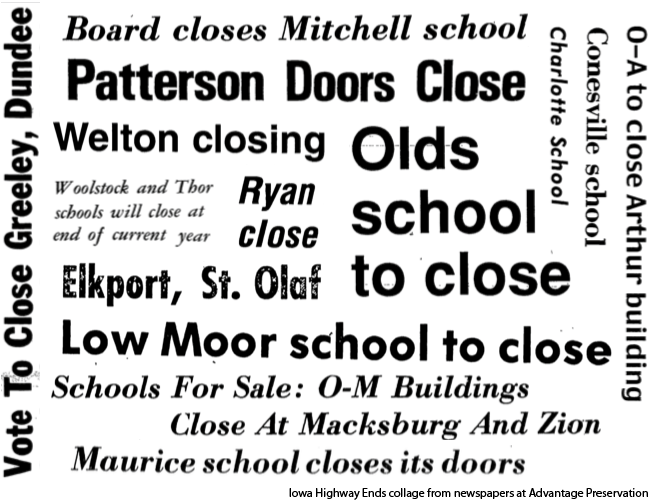
Someone took the last shot in an official basketball game in the gymnasium.
Someone was the last student out the door on the last day.
Someone was the last school district employee to lock the doors.
When I started my school closure timeline a decade ago, I settled on 1980-81 for a start date, as a nice round number, as the year Corwith-Wesley-LuVerne started sharing, and because I figured it would be hard to go back farther. Since then, lots of Iowa newspapers have been digitized through Advantage Preservation. Months of research can be condensed into seconds. There are briefs and tiny headlines I never would have seen in microfilm but rapidly appear with a text search.
A few months ago, I decided to start seeing how much I could find. Now, I have what I believe is the most comprehensive compilation of school district evolution in Iowa.
Most of this work, sadly and expectedly, is related to closures — the year a tiny community lost its only school building. (I freely admit I am less interested in closures of sites in large cities, and only note them when I happen across them.) Demolitions figure into it too; consider that someone who graduated from East Greene High School a decade ago now has only the Rippey gym to revisit, and the district name itself has faded into history. Forty years of schools in Iowa can be summed up, although wildly oversimplified, in three lines.
- 1953-73: The Boomers are coming! The Boomers are coming!
- 1973-83: The Boomers are going! The Boomers are going!
- 1983-93: The Boomers are gone! The Boomers are gone!
After looking at construction stories and the school timeline, one can see the pattern easily. A surplus of young children, plus the sweeping closures of one-room schools, bring about new one-story additions to hold them. By the mid-’60s and early ’70s, the wave flows into new high schools in Iowa’s largest cities and centralized sites for smaller districts. At nearly the same time, elementary schools noticed the first signs of a different complication: Generation X.
Decorah Supt. Wayne Burns said, “There’s no question but what the birth rate is down.” Central Community Supt. R.D. Buckner of Elkader, pointing to the pre-school census for Central, said, “Please note there is a distinct drop in 3-year-olds.”
— “Crowded classroom outlook varies in Iowa,” Cedar Rapids Gazette, October 15, 1967
Into the Carter-Reagan years, it was the farm crisis. Elementary-only sites in the 1980s closed by the truckload. The cascade of sharing and reorganizations in the last span was aided by state incentives, but mostly, so many schools just didn’t have the numbers anymore.
I’m going to share my findings in a series of blog posts, and then upload a new timeline page with all the new listings.
On a completely related note, Waukee Northwest High School opens next week. Waukee becomes the tenth city in Iowa to have two high schools, and the district will build at least four new schools in the next four years. If 700 new students show up there, as its superintendent speculates in the KCCI story, the new crop alone would be larger than more than half of Iowa’s 327 districts, rivaling Hudson or Panorama.
